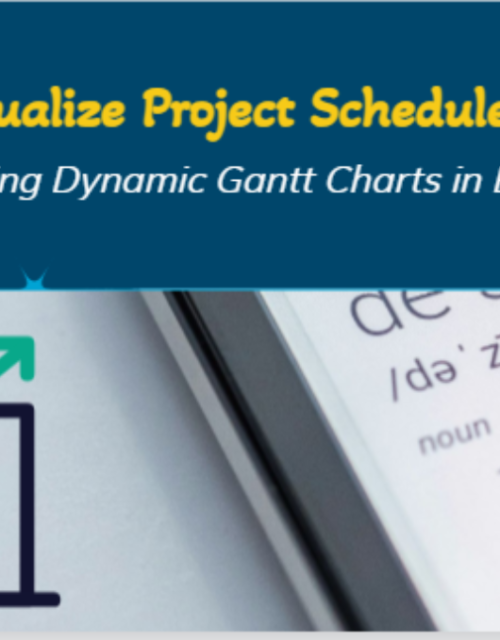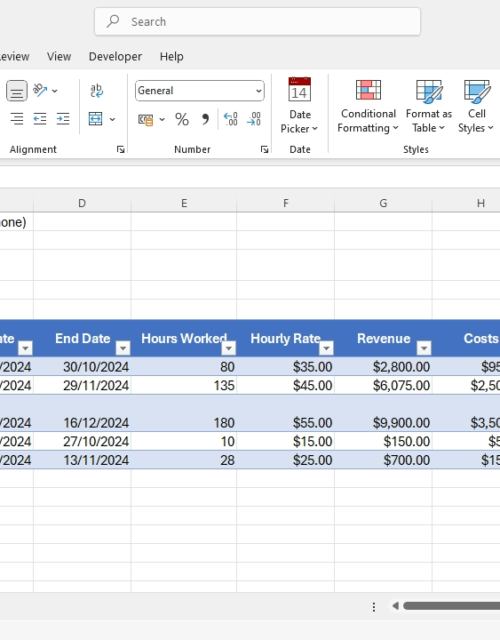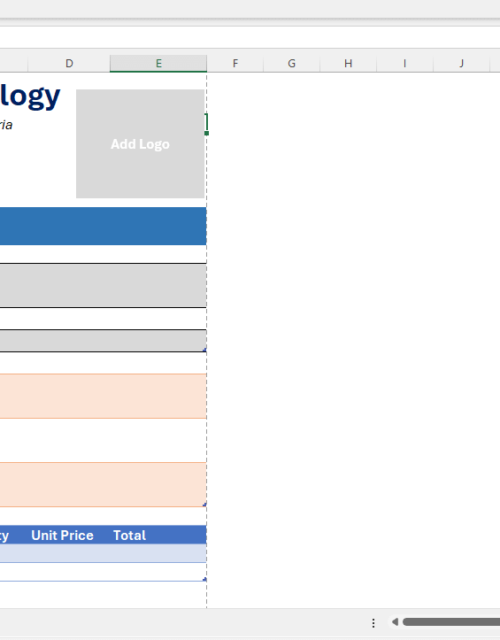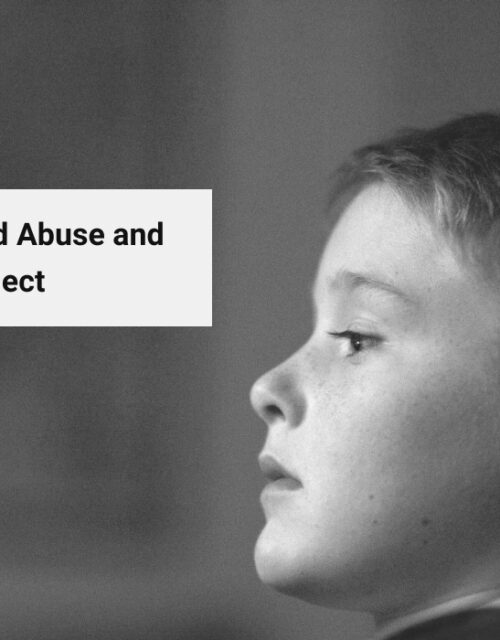Web Design for Nonprofits: The Dynamic Impact of Professional Donation-Driven Websites
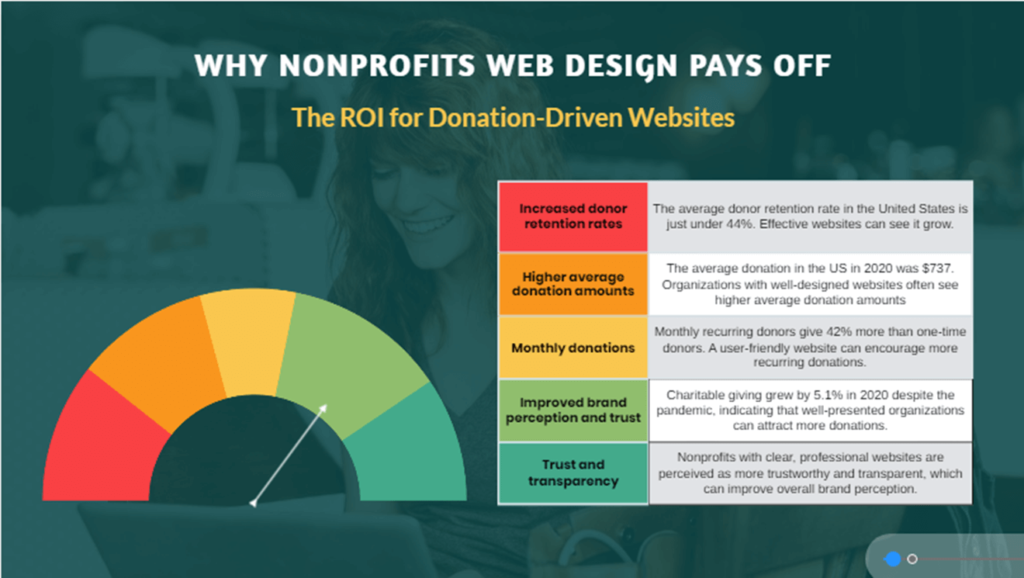
Do you know that 75% of donors look for concrete information about a nonprofit’s achievements before deciding to give? (Nonprofit Tech for Good). A handy tool that makes it quick and possible is a website.
It is therefore apparent that web design for nonprofits is invaluable. Aside from the above statistic, a dispensation where digital presence can make or break an organization calls for a nonprofit web design.
A well-designed website can help nonprofits build trust, engage with their audience, and ultimately, drive more donations.
Let’s dive deep into the world where pixels meet philanthropy, and discover how a well-crafted website can turn casual browsers into passionate donors.
Table of Contents
The Digital Heartbeat of Modern Philanthropy
A nonprofit’s website is often the first point of contact for potential donors, volunteers, and supporters. A well-designed website can make a lasting impression, convey the nonprofit’s mission and values, and encourage visitors to take action.
Imagine a world where every click has the potential to change a life. That’s the power of nonprofit web design. It’s not just about looking good; it’s about creating a digital ecosystem where compassion meets action.
Key statistics that demand attention
Here are some key statistics that highlight the importance of web design for nonprofits:
- 25% of online donations were made on a mobile device in 2022 (NPTech for Good).
- The number of transactions completed through mobile devices has increased by 50% (Donorbox).
- Nonprofits with optimized websites see a significant increase in their online revenue (Techsoup).
- NPTrust found that 64% of donors prefer to give online with either a credit or debit card.
- Qgiv noted that good design can help nonprofits earn more and higher donations
The above statistics and more underscore the fact that a website for nonprofits will help them increase their donations yearly.
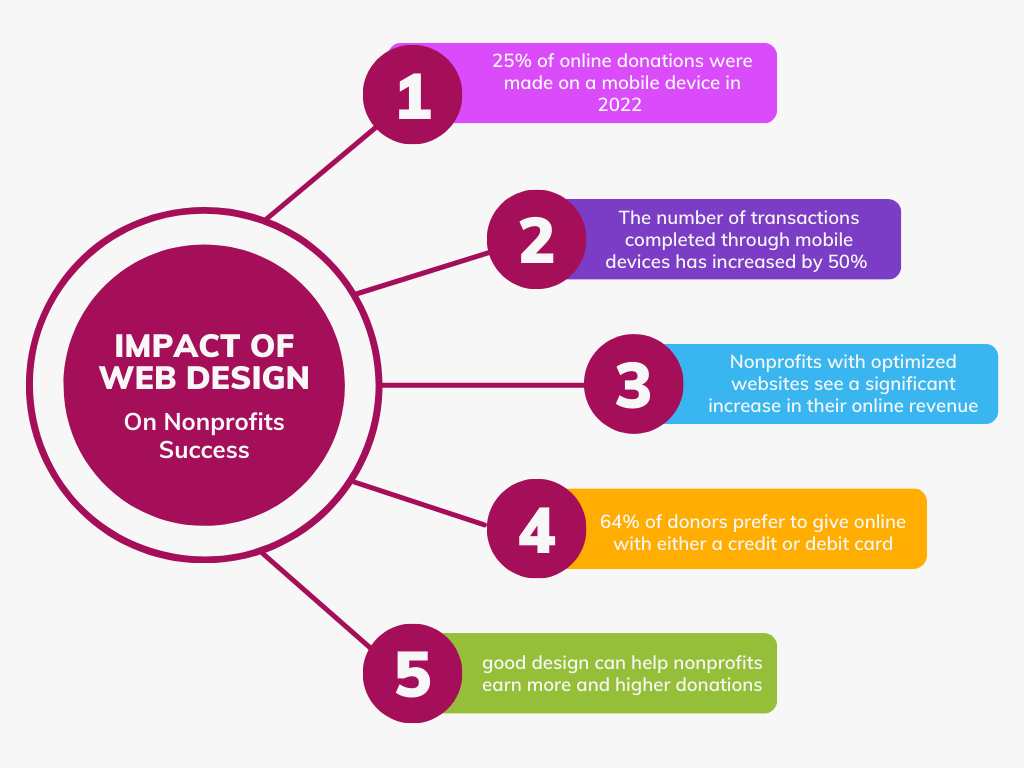
Current trends for web design for nonprofits
The nonprofit sector is constantly evolving, and web design trends are no exception. Here are some current market trends and statistics that nonprofits should be aware of:
- Mobile optimization is crucial: Qgiv. Suggests that nonprofits with mobile-friendly websites see significantly more online donations.
- Online giving is on the rise: According to the Blackbaud Institute’s Charitable Giving Report, online giving grew by 20.7% in 2020. The average online donation was $177, which was a $29 increase from the previous year.
- Social media integration is key: Only 20% of nonprofits feel extremely confident that they’re maximizing their social media potential. (Hootsuite)
- Storytelling is essential: According to Storly.ai, narratives that evoke emotions lead to higher donation rates.
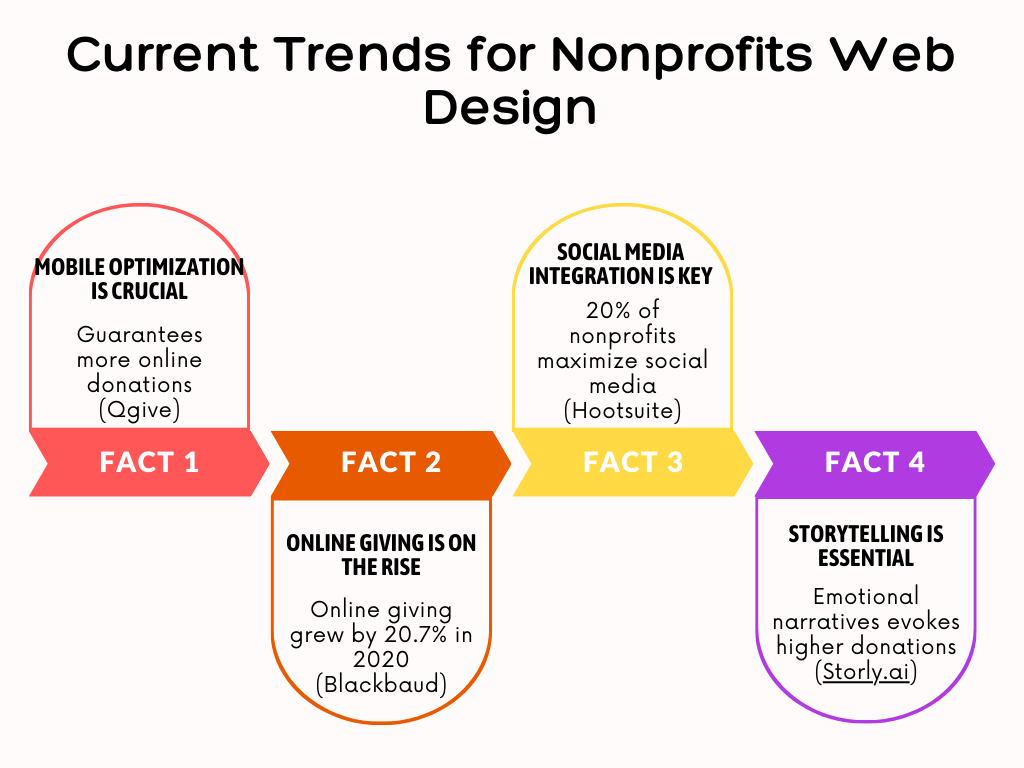
Redefining the Nonprofit Digital Landscape
Gone are the days when a basic website sufficed. Today’s donors are digital natives, expecting an online experience that’s not just functional, but emotionally resonant and intellectually engaging.
Therefore, a donation-driven website should have several key elements that encourage visitors to take action. Here are some essential elements to include:
- Clear and concise mission statement: A clear and concise mission statement should be prominently displayed on the homepage.
- Prominent donation button: A prominent donation button should be visible on every page of the website.
- Compelling storytelling: Use storytelling techniques to convey the nonprofit’s mission and impact. Visual storytelling can make a great impact.
- Easy navigation: Guide visitors on a journey from curiosity to commitment. Ensure that the website is easy to navigate, with clear and concise menus and links.
- Mobile optimization: Ensure that the website is optimized for mobile devices, with a responsive design and fast loading times. Always remember that in the race against indifference, every second counts.
- Social media integration: Integrate social media feeds and links to promote the nonprofit’s cause and drive donations.
The science of digital generosity
Let’s break down the psychology behind what makes a nonprofit website not just good, but transformative.
Color Psychology in Nonprofit Web Design
Color plays a pivotal role in nonprofit web design, influencing how potential donors perceive and interact with an organization.
Strategic use of color can enhance brand identity, evoke emotional responses, and guide user behavior. Color psychology therefore plays a pivotal role in conveying an organization’s mission and values.
- Blue: Trust and stability – Blue is often associated with trust, stability, and professionalism, making it an excellent choice for the main color of a website to establish credibility.
- Green: Growth and environmental causes – Green symbolizes growth, health, and renewal. It is ideal for environmental or social welfare organizations to highlight their commitment to these areas.
- Orange: Enthusiasm and action – Orange, with its vibrancy, suggests creativity and enthusiasm, suitable for calls to action or to draw attention to key initiatives.
- Purple: Creativity and wisdom – Purple represents luxury and wisdom, often used to denote sophistication and to appeal to donors for high-end causes.
Additional colors like red can be used sparingly to invoke urgency or importance, suitable for donation buttons or critical campaigns.
Yellow, associated with optimism and attention-grabbing, can be effective for highlighting success stories or positive outcomes.
It’s crucial to use these colors strategically; for instance, blue can be used for the navigation bar or headers to promote a sense of reliability, while green can be used in backgrounds or icons to reinforce a message of growth.
Orange, being an attention-grabber, is best used for calls to action, and purple can be reserved for sections that discuss visionary statements or long-term goals.
The key is to align the color choices with the emotional response you wish to elicit from the site’s visitors, ensuring that the colors reinforce the nonprofit’s branding and message effectively.
Understanding the cultural and psychological implications of color choices is crucial for effective communication and engagement in the digital landscape.
It’s not just about aesthetics; it’s about creating a visual language that aligns with an organization’s mission and values.
The Power of Whitespace
Whitespace is a strategic element in design that allows for better readability and focus. It’s like a breath of fresh air, helping users to process information more efficiently and create a more engaging experience.
Contrary to the urge to fill every pixel, strategic use of whitespace can increase donations. According to UX Booth, effective use of whitespace can improve user experience and lead to higher conversion rates.
This is especially important for nonprofits, where the message of compassion and impact needs to resonate clearly and powerfully with potential donors. Balancing whitespace with compelling content can significantly enhance the overall user experience and, in turn, drive more donations.
Whitespace is not just a space; it’s a breathing room for compassion.
Accessibility: The Universal Language of Inclusion
Accessibility in web design is crucial for nonprofits, as it ensures that their services and information are available to a wider audience, including those with disabilities.
Web accessibility isn’t just a legal requirement; it’s a moral imperative. By ensuring your website is navigable by all, you’re not just widening your donor base – you’re living your values. Ensure your nonprofit website is accessible to many by implementing:
- High contrast text: Implementing high contrast text on websites can greatly aid individuals with visual impairments. This can be achieved by using CSS to set a higher contrast ratio between text and background colors.
- Alternative text for images: Alt text for images involves adding descriptive text to image tags, allowing screen readers to convey the content of images to users who cannot see them.
- Keyboard navigation: Keyboard navigation enables users with motor disabilities to navigate a website using only a keyboard. This can be facilitated by ensuring logical tab order and using ARIA (Accessible Rich Internet Applications) roles and properties.
- Closed captions for videos: Closed captions for videos are transcripts of the audio content synchronized with the video, which are indispensable for the deaf and hard of hearing community.
- Screen reader compatibility: Lastly, screen reader compatibility can be ensured by using semantic HTML. It helps screen readers understand and interpret the structure and content of web pages.
By incorporating these elements, nonprofits can create inclusive web environments that cater to the needs of all users, reflecting the universal language of inclusion.
From Pixels to Purpose: Key Elements of a Donation-Driven Websites
High-converting nonprofit websites are crafted with strategic elements that engage visitors and encourage donations.
- Compelling Above-the-Fold Content: Compelling above-the-fold content serves as the digital first impression, capturing attention and conveying the mission succinctly.
- Clear and Prominent Donation Buttons: Clear and prominent donation buttons are crucial, reducing friction in the giving process. It makes giving as easy as breathing.
- Impact Metrics: Impact metrics are a powerful tool, visually demonstrating how contributions lead to tangible outcomes. Show, don’t just tell, how donations make a difference.
- Social Proof: Social proof, through testimonials and success stories, builds trust and connects emotionally with potential donors.
- Multimedia Content: Multimedia content like videos and infographics can significantly increase engagement, making complex information accessible and shareable.
- Mobile-First Design: A mobile-first design ensures the site is accessible anywhere, reflecting the modern donor’s lifestyle.
- Load Time Optimization: Lastly, load time optimization is vital; as research by Kissmetrics highlighted, even a one-second delay can lead to a 7% reduction in conversions. (Kissmetrics, 2022)
Together, these elements form a cohesive strategy that can turn interest into action, driving the success of nonprofit missions online.
The donation form: where intent meets action
Your donation form is not just a transaction point; it’s the culmination of your donor’s journey. Make it count.
- Keep it simple: Reduce fields to the essentials
- Offer multiple payment options: Credit cards, PayPal, and even cryptocurrency
- Use security badges: Reassure donors their information is safe
- Implement smart defaults: Suggest donation amounts based on averages
- Enable recurring donations: Turn one-time givers into lifelong supporters
Anatomy of an Optimized Nonprofit Donation Form
Optimizing your nonprofit’s digital reach
Optimizing a nonprofit’s digital reach is crucial in amplifying its mission and maximizing its impact within the community.
In the vast digital ocean, make sure your beacon of hope shines the brightest, implement:
Local SEO: Your Community, Your Impact
Local SEO is a powerful tool for nonprofits, allowing them to enhance their visibility in local search results and connect with community members who are actively seeking ways to contribute or benefit from their services.
By focusing on location-based keywords and ensuring their Google My Business listings are accurate and comprehensive, nonprofits can significantly improve their local digital footprint. Therefore, ensure you
- Optimize for “[Cause] in [City]” searches
- Claim your Google My Business listing
- Encourage and respond to reviews, and
- Create location-specific landing pages
Voice Search Optimization: Speaking the Language of Compassion
Voice Search Optimization is another vital aspect, especially as the use of voice-activated devices continues to rise.
Nonprofits can adapt to this trend by incorporating natural, conversational language into their content, targeting featured snippets in search results, and structuring information to provide quick, clear answers to common questions.
With voice search on the rise, optimize for natural language queries such as:
- “How can I help homeless people in my area?”
- “What charities support mental health near me?”
- “Where can I volunteer this weekend?”
Content Strategy: Educate, Inspire, Convert
A robust Content Strategy is essential for educating the public, inspiring action, and converting interest into support. This involves creating and distributing valuable, relevant content that resonates with the audience’s values and interests.
By leveraging storytelling, utilizing various content formats, and measuring engagement through analytics, nonprofits can create a narrative that not only informs but also motivates the audience to become active participants in their cause.
The following will help you create a content ecosystem that nurtures potential donors through their journey:
- Awareness: Blog posts on industry trends and issues
- Consideration: Case studies and impact reports
- Decision: Donor stories and detailed program information
The Technical Foundation of Trust
The Technical Foundation of Trust in web design for nonprofits is a multifaceted concept that hinges on several key elements.
SSL certificates: the digital handshake
SSL Certificates, often referred to as the Digital Handshake, are paramount in establishing a secure connection between a user’s browser and the server, ensuring that sensitive data transmitted is encrypted and protected from interception or tampering.
An SSL certificate is not just a technical requirement; it’s a trust signal. According to GlobalSign, sites with SSL see a 15% increase in conversion rates (GlobalSign, 2022).
This is particularly crucial for nonprofits, which often handle personal donor information and require a foundation of trust to encourage online engagement and donations.
Page speed: the heartbeat of user experience
Page Speed is another critical factor; it directly influences user satisfaction, engagement, and retention rates. A swift and responsive website reflects the organization’s respect for the user’s time and contributes positively to their overall experience.
Every second counts. WPExperts noted that a 1-second delay in page load time can result in a 7% reduction in conversions.
Measuring success: analytics for impact
Web analytics allows nonprofits to gauge the effectiveness of their online presence. By analyzing website traffic, user behavior, and conversion rates, organizations can make data-driven decisions to optimize their web design and content strategy, ultimately enhancing their ability to fulfill their mission.
What gets measured, gets managed. Key metrics to track include:
- Donation conversion rate
- Average donation amount
- User flow through your site
- Bounce rate on key pages
- Time spent on impact stories
Each of these components plays a vital role in building a trustworthy and efficient online environment that supports a nonprofit’s goals and values.
Emerging Trends in Web Design for Nonprofits
Recent developments in web design are revolutionizing how nonprofits engage with their audiences and stakeholders. To stay ahead of the curve, use these cutting-edge strategies:
- Gamification: Gamification introduces a playful, interactive element to websites, encouraging visitors to participate more actively and fostering a deeper connection with the nonprofit’s mission. Use it to turn support into an engaging experience.
- AI-Powered Chatbots: To provide instant support and guide donations use AI-powered chatbots. This represents another significant trend, offering real-time communication and personalized assistance, thereby enhancing user experience and operational efficiency.
- Virtual Reality Tours: Use VR tour to immerse donors in the impact of their contributions. This will help create a sense of belonging that converts casual donors to lasting partners.
- Blockchain for Transparency: Blockchain technology is gaining traction for its ability to ensure transparency, particularly in donation tracking, which bolsters donor trust and potentially increases funding. Use it to show the journey of every donated dollar.
- Personalized User Journeys: Finally, by leveraging data analytics and user behavior, nonprofits can tailor the online experience to individual preferences and needs, leading to higher engagement and conversion rates.
These trends not only enhance the digital presence of nonprofits but also contribute to a more dynamic, inclusive, and effective online ecosystem. Implementing such innovations can lead to transformative changes in how nonprofits operate and engage with their communities
Why Nonprofits Web Design Pays Off: The ROI for Donation-Driven Websites
Available data shows why a website is an ideal investment for nonprofits whose bulk income comes from donations. With a modern website, nonprofits would have:

Increased donor retention rates
Retention Rate: The average donor retention rate in the United States is just under 44%. However, organizations with effective web design and user-friendly donation processes can see retention rates significantly higher. [1]
Fundraising Effectiveness Project: According to the Fundraising Effectiveness Project, organizations that focus on improving their online presence and user experience have seen an increase in donor retention rates.[2]
Higher average donation amounts
Average Donation: The average donation in the US in 2020 was $737.[3] Organizations with well-designed websites often see higher average donation amounts due to ease of use and trust.
Monthly Donations: Monthly recurring donors give 42% more than one-time donors. A user-friendly website can encourage more recurring donations.[4]
Improved brand perception and trust
Trust and Transparency: Nonprofits with clear, professional websites are perceived as more trustworthy and transparent, which can improve overall brand perception.[5]
Giving USA: Charitable giving grew by 5.1% in 2020 despite the pandemic, indicating that well-presented organizations can attract more donations.[6]
Enhanced volunteer recruitment
Volunteer Engagement: Organizations with engaging and informative websites can attract more volunteers by showcasing opportunities and impact effectively.[7]
Nonprofit Source: Nonprofits with strong online presence and clear calls-to-action for volunteering see higher volunteer recruitment rates.
Better data collection for targeted campaigns
Data-Driven Campaigns: Effective web design allows for better data collection and analysis, enabling more targeted and successful campaigns.
Nonprofits with advanced data collection tools on their websites can tailor their campaigns more precisely, leading to better engagement and results.[8]
Conclusion
A well-designed website is critical for nonprofits to increase donations, raise awareness, and achieve their mission.
By including key elements such as a clear and concise mission statement, a prominent donation button, and compelling storytelling, nonprofits can create a donation-driven website that drives results.
Nonprofits organization should understand that website is more than a digital brochure; it’s a platform for change. By investing in strategic web design, you’re not just building a site – you’re constructing a bridge between intention and impact.
Ready to transform your digital presence into a powerhouse of philanthropy? Our team of compassionate coders and design dreamers is here to help. Let’s craft a website that doesn’t just tell your story, but becomes part of it.
Contact us today, and let’s start changing the world, one pixel at a time.
Empower Your Cause with Strategic Web Design
Remember, in the digital age, your website is often the first handshake, the first smile, and the first opportunity to make a difference. Make it count.



